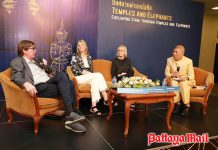Christopher G Moore is one of Thailand’s foremost authors. His Vincent Calvino series has 15 titles, his other novels 11 titles, non-fiction has five and he has three anthologies which he has edited as well as contributed items to them.
This new book, The Age of Dis-Consent (ISBN 978-616-7503-31-8, Heaven Lake Press, 2015) was literally hot off the press when it arrived on the reviewer’s table.

He has split the book into seven sections, beginning with Thailand in the Age of Dis-Consent, followed by Thai law enforcement and cultural mindset, Evolution of violence and the border-less world, Crime investigation in a changing world, Space, Time Technology and Cultural gravity, Information and theory of mind and finally, On writing and authors.
Moore discusses neutrality as a remedy for political stalemate in Thailand, looking objectively at the options, and coming to the conclusion that mindset and culture has to change in Thailand for there to be resolution of political differences. He opines, “We are a long way from reaching that point. Meanwhile we remain hostages to personalities who will never be expected to pay for their crimes.”
The book’s content is current, as the chapter on Mitsutoki Shigeta discusses the background and future as presented by this wealthy Japanese who is building up an empire of his children. “A thousand children would be the ultimate immortality-vanity project. Leaving a legacy population of genetically related people who will shape the political, social, economic and demographic fate of more than one country.”
His final essay looks at the “persona” as committed to posterity by painters such as Lucian Freud and Francis Bacon notating them as two of the most important painters in England over the past hundred years. (Bacon has an interesting connection with Pattaya, of which Pattaya old hands will be aware.) Moore looks at the commitment artists have in recording all the details, in one instance, Martin Gayford sat for one and a half years for a portrait by Lucian Freud and penned a memoir “Man with a Blue Scarf: On Sitting for a Portrait by Lucian Freud.” A commitment by both the artist and the sitter.
What becomes very obvious in these essays is the fact the Moore is far more than just a good story teller. He is a thinker who is able to transfer his thoughts into the written word. This is not an attribute that all thinkers have.
Moore shows something of his own intellectual reasoning with: “If there is a single reason why I continue to write books and essays, it is to continue on a journey of exploration of what is in front of me …”
For B. 495 (Bookazine) you have the starting point for hours of discussion, at which good essayists excel. It would be nice to hammer points out in a one on one with him; however, since that would be difficult to arrange, suggest that one of your own literary sparring partners buy the book as well and set aside several weekends and several bottles of red (try Stonefish shiraz) and thrash out the discussion points one by one!




